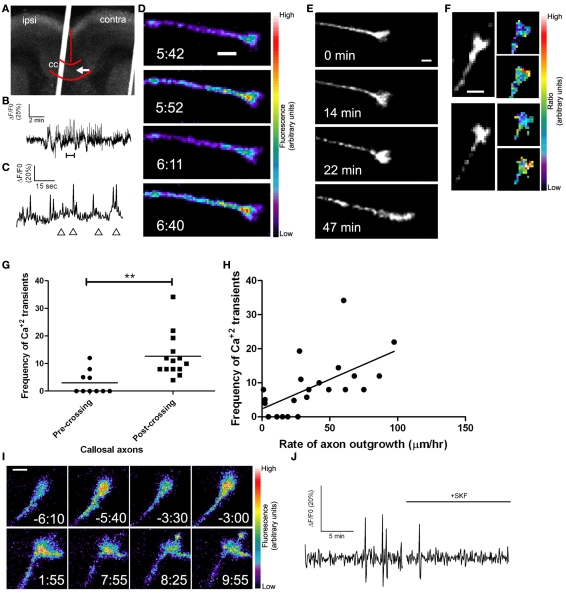Figure 8.
Callosal axons express spontaneous calcium transients positively correlated with rates of axon outgrowth. (A) A coronal cortical slice electroporated with GCaMP2 plasmids into the left cortex. Arrow indicates postcrossing (contra) position of the growth cone imaged in (D). Borders of the callosum (cc) and the midline are outlined in red. (B) Tracing of calcium activity measured by changes in GCaMP2 fluorescence over baseline. Calcium activity increases after a few min. (C) Tracing of calcium activity from (B) zoomed in to the time shown in the bracket. (D) Fluorescence images of the growth cone measured in (B,C) at time points indicated by the arrowheads in (C). (E) Within 20 min of the onset of calcium activity shown in (B) the axon begins to advance rapidly through the contralateral callosum. (F) Examples of single calcium transients measured by ratiometric imaging of growth cones co-expressing DsRed2 and GCaMP2. (G) Plot of frequencies of calcium transients in pre- or post-crossing callosal axons, **p < 0.01, t test. All frequencies are in transients/h. (H) Scatter plot of the frequency of calcium transients vs. the rate of axon outgrowth in individual callosal axons. The line represents the least-squares linear regression (slope significantly non-zero, p < 0.01). (I) An example of spontaneous calcium transients (top row) which are attenuated by application of SKF at time 0.00 (bottom row). (J) Tracing of calcium activity in the growth cone shown in (I) before and after application of SKF. Scale bars 10 μm except (I) which is 5 μm. Pseudocolor calibration bars indicate fluorescence intensity (D) or ratio of GCaMP2 to DsRed2 fluorescence intensities (F) in arbitrary units. (Reprinted from Hutchins et al., 2011).

